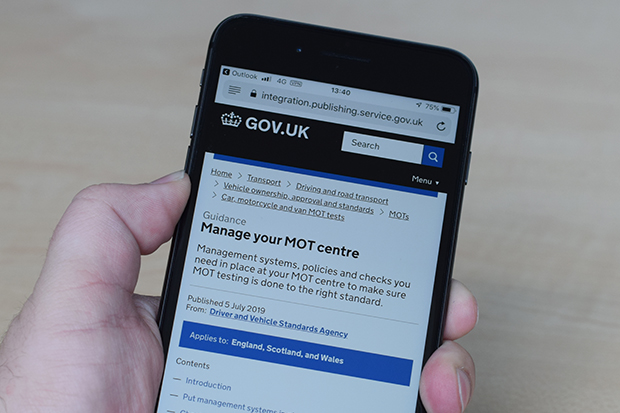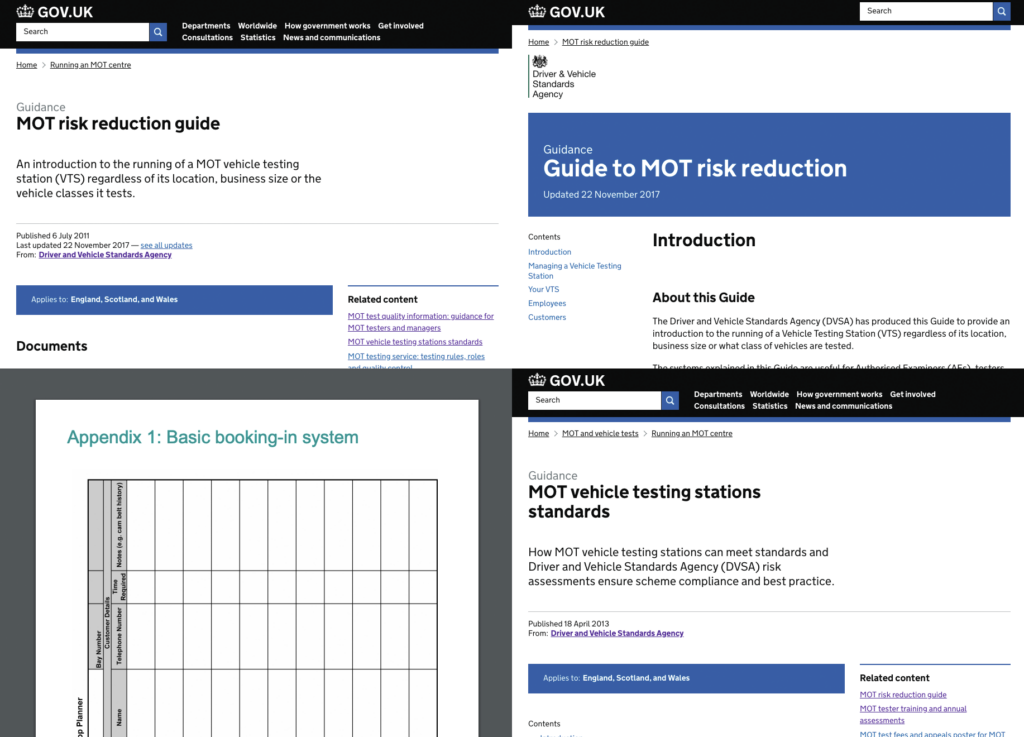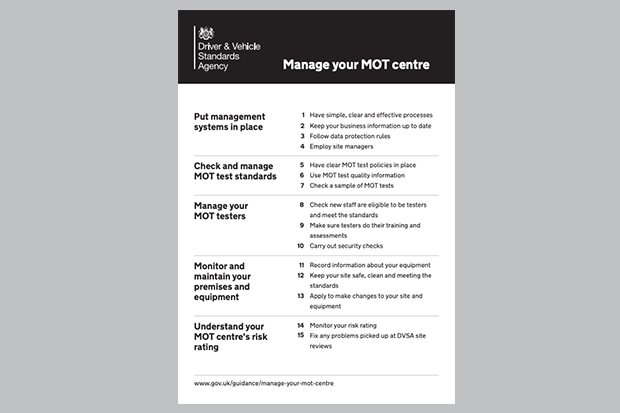 At DVSA, our priority is to help everyone keep their vehicle safe to drive.
At DVSA, our priority is to help everyone keep their vehicle safe to drive.
Making sure that MOT testers carry out every MOT test to the highest possible standard plays a vital role in this. And to do that, MOT managers need access to good guidance about managing MOT centres effectively.
That’s why we’ve just published a new guide setting out 15 important points that can help you manage your MOT centre. It’s vital reading for authorised examiners (AEs), AE designated managers and site managers.
We know that there are lots of different ways to manage an MOT centre. Those methods will differ based on your individual circumstances.
So this new guide sets out 15 important points you need to think about. You might use different methods from the examples we give in the guide. And if they’re effective and work for you, that’s absolutely fine. Our goal here is to make sure you’ve considered these areas and have effective measures in place.
The problems with our old guidance
One of the reasons we’ve published this new guide is because there were problems with the old guidance.
It was hard to find
The old guidance was hard to find. It was split across 3 separate web pages.
The way those pages were titled did not make it clear who the guidance was for. It meant that the guidance could come up in search results for motorists just looking for information about getting an MOT. That’s frustrating for them, but it slowed you down finding what you needed, too.

It was a lengthy read
The old guidance was long - over 6,500 words long, to be precise.
Assuming you have an average reading speed of 200 words per minute, it would take about 35 minutes to get through all of it.
But data about how GOV.UK is used tells us that people actually spent about 3 minutes 30 seconds reading it.
Among all that guidance, there were 11 different files to download. But it turns out, not many people were actually downloading them. In fact, only 1 in 12 people were downloading some of them.
With all the clutter that people were not interested in getting in the way, it meant you could easily miss the important bits.
It was out of date
The other big problem with the old guidance was that it did not reflect our current approach to risk ratings and site reviews.
Obviously, not very helpful.
How we’ve tried to fix these problems
We’ve scrapped all the lengthy old guidance and started again, with a clear focus on what you need to know to manage an MOT centre.
Most importantly, all of this information is in a single guide. We hope this will stop people going around in circles trying to find what they need.
We’ve given it a title of ‘Manage your MOT centre’ so that it’s clear what it’s about to anyone who finds it in search results.
The new guide is a lot shorter than what went before. It’s about 2,800 words long, which takes about 15 minutes to read – half the length of the old guidance.

It’s split into 5 very clear areas. And each of those is then broken down into some important points. They cover everything from keeping your business information up to date, through to different ways you can do quality checks, and fixing any problems that are picked up at a DVSA site review.
The content has been thoroughly rewritten to make it clearer. So whether you’ve been in the industry for years or are just starting out, you can read this and understand what’s involved.
Getting feedback on the guide
We talked to the MOT trade user group about the new guide at the end of May.
They’ve reviewed a draft version and given us some really useful feedback to help make further improvements and clarifications.
Over 90% agreed that the new guide is clear and easy to understand, and that they’d recommend it to other people in the MOT industry. Everyone who gave us feedback agreed that it has a clear and logical structure.
I’m really grateful to everyone who took time to review it and give their feedback.
What we’ll do next
With the guide now available, it’s over to you to see what you think.
Towards the bottom of the guide, there’s a blue bar where it asks ‘Is this page useful?’
Use this to tell us what you think, and give us more feedback so we can keep improving the guide.

And we’d like to hear how you’re using the guide. If you decide to change the way you do things after reading it, and would be interested in sharing your experience here in a guest blog post on Matters of Testing, email social.media@dvsa.gov.uk.
A reminder about comments on Matters of Testing
We encourage and welcome open, lively debate on the Matters of Testing blog. But you must follow the rules for commenting. This includes keeping comments on the topic of the blog post.
30 comments
Comment by michael coote posted on
is testing older vehicles (agewise) still making risk rating higher , its just my age is alot higher than the national average and the way i see it if am moting these older vehicles without a complaint or concern arent i doing well risk wise ?
Comment by Roland Batchelor posted on
Hi,
Point 7 relates to QC checks and differs from the MOT testing Guide B6.11.f. The wording implies that both items (i) & (ii) must be carried out whereas the Guide inserts the word 'or'.
"f. Whoever is conducting the quality assurance check
i) Closely watch all parts of the test as they are carried out or
ii) Closely observe the testing process, and conduct a full re-
examination of the vehicle to check standards application.
g. Once the Tester has completed the test, which will be the subject of a QC check any difference in the test result, test standards or observed defects must be discussed and resolved prior to confirmation of the test result on the MOT Testing Service."
Having to carry out both actions is too onerous particularly at a busy site employing a large number of testers.
Please amend to align with the Guide.
Thanks
Roly
Comment by John Ploughman (DVSA) posted on
Hi Roland
Thanks for pointing this out. We've updated the wording to clarify that the person doing the check should do 'either'.
Best wishes
John
Comment by Roland Batchelor posted on
Thank you John.
Comment by Lou posted on
Quite frankly I want to know the vehicles my family and friends are driving around in are safe to do so, if that means I test them, then I'll test them!!
It seems like you've done a great job of annoying people by suggesting we're incapable of doing our jobs properly.
Comment by Ronnie posted on
Julia when people have been sent to prison for being a bad testers why ? are they still allowed to test ?
Comment by Julia (DVSA) posted on
Hi Ronnie
We would look at the testers conviction in line with the Rehabilitation of Offenders Act 1974. Part of the conditions for being an MOT tester is to be of ‘good repute’. DVSA will decide this on individual cases. More information on returning to testing: https://www.gov.uk/become-an-mot-tester/returning-to-mot-testing
Comment by Ronnie posted on
They can't be of good repute if they have been sent to prison for serious infringement s of the TEST scheme
Comment by Nigel posted on
I think its outrageous that you at the dvsa have this very low opinion of us testes of being dishonest
As a mot tester we should be trusted to mot any vehicle regardless of who it belongs to. There's a message here to all techs who want to be an mot tester as soon as you do your under suspicion straight away from dvsa.
Comment by nij@ mercury posted on
my family & friends are important to me & no way would i let them drive a defective vehicle or look the otherway & issue a pass certificate knowing the vehicle had defects
Comment by Hooters posted on
Trying to be constructive here....
Can you let us have our regional VE's mobile numbers please as their advice will come in handy if we get any queries; After all, these are the guys that will visit us and pass judgement. And, ringing the 'main' number is often so frustrating. And, no one ever responds to my feedback (so I don't know whether i'm wasting my time or not).
Many thanks.
Comment by Julia (DVSA) posted on
Hi there
Thank you for your comment. However, we'll still be using the call centre who are able to answer a wide variety of questions.
Comment by richard posted on
Point 5 . "testers not testing the vehicles of family and friends (in case they pass a vehicle that should have failed)"
This is like saying an electrician cant re-wire his own house, so what your saying is family & friends cant come to an mot testing station we work at , especially if there is only one tester at the station. The vast majority of MOT testers do a first class job so why cant we be trusted to do family & friends ?
Comment by Julia (DVSA) posted on
Hi Richard
The guide's purpose is to help AEs run their MOT centre well and also to identify and manage risks along the way.
It has always been good practice not to test a vehicle you have direct interest in. This reduces the risk of influencing the test result. Similarly to the electrician you mention re-wiring their home, they would be wise to have it certified by another qualified person.
Comment by mark posted on
what a load of nonsense thats basically saying we are fiddling the tests
Comment by Julia (DVSA) posted on
Hi Mark
As i commented to Ronnie, this is guidance to help testers follow best practice.
Comment by Martin posted on
DVSA really do have a low opinion of mot testers when it comes down to it.
I class myself a professional so be it family,friends or the pope I would test the vehicle to the same standard.
I along with many others no doubt take offence at your inference.
Comment by Julia (DVSA) posted on
Hi Ronnie
This is not a rule, just best practise we advise garages to follow.
Comment by d m posted on
i am beginning to think that the people who are writing these rules
have come from a criminal background and think every one is the same as them
most items written about just now is about fraud/security/ check your staffs background etc ,and how to correct what your doing wrong if you havent got a green rag
just had a look at mine looks like i need to looking for track rods ends,,more wiper blades ,o and a missing wheel bolt
But i have not seen any one saying keep up the good job thanks
Comment by castrolrob posted on
its always been the case that youre expected to be more stringent with vehicles in which you have a personal interest,its why I generally get a.n.other tester to do mine.ok so afterwards I go over it to find what it SHOULD have failed on but im just anal in that way.i value my own friends and family too highly to test to the substandard mot level in the first place .ministry standards are WAY lower than mine which raises the interesting question of how youd stand on appeal cos last I heard we weren't allowed to alter our standards to suit ourselves or indeed the ministry.
Comment by mark posted on
i agree with richard on this one..i for one, and as will many other testers,continue to test family and friends vehicles.to say standards are less when doing this is borderline degrading i think to the tester/testers out there that carry out mot tests to friends/families vehicles.
Comment by John Ploughman (DVSA) posted on
Hi everyone
Thanks for the feedback about point 5 (have clear MOT test policies in place) in the guide.
As Julia has already said, it has always been best practice to not carry out MOT tests on your family and friends' vehicles. This was covered in the previous guide to MOT risk reduction.
We know that the vast majority of MOT testers do an excellent job making sure that vehicles are safe to drive. We also know that they take safety exceptionally seriously for their family and friends' vehicles.
However, the reality is that a minority of people do deliberately undermine the standards. They risk unsafe vehicles being on the roads, and risk damaging the reputation of the MOT industry.
The guidance is there to help MOT managers reduce the risk of this happening in their business.
So, we've updated the guidance in point 5 to make it clearer that your policies should cover whether you allow your MOT testers to test their family and friends' vehicles. If you do, it should cover how you'll manage the risk to make sure those tests are done to the right standard.
Remember, the guide sets out 15 important points that you need to think about. You can use different methods from the examples given, as long as they’re effective.
Thanks
John
Comment by Nigel P posted on
As I understand this is available on the gov uk website, so it is readily available for the public to see, so as an AEDM or Tester we are to be scrutinised by the public. Is this morally correct?
Comment by Julia (DVSA) posted on
Hi Nigel
As explained in the blog post, the new guide is on GOV.UK.
Information about individual testers and centres is only available through the MOT testing service. Access to this is limited to those involved in MOT testing.
The guidance is just that - information to help you efficiently run an MOT centre and advice on managing test standards and premises, for example.
Comment by Graham posted on
"Over 90% agreed that the new guide is clear and easy to understand, and that they’d recommend it to other people in the MOT industry"
I assume then that 10% didn't agree. Extrapolate that to the full number of MOT Stations and that equates to over 2,300 MOT stations who didn't agree.
Since this will be used by VEs as a basis for site risk ratings, it should have been compiled so that it would be acceptable to a far higher proportion.
It demonstrates that it should have been circulated for comment to a much wider sample of the industry.
Comment by Julia (DVSA) posted on
Hi Graham
The other 10% of people offered various comments so you can't assume they all disagreed.
Comment by John Ploughman (DVSA) posted on
Hi Graham
Is there anything that you’re finding particularly unclear about the guidance?
If you can let us know which specific parts, we’ll be able to keep on improving it as I explained in the blog post.
Thanks
John
Comment by glynne jones posted on
Yes, approved
Comment by Sean McCarthy posted on
Hi
Can you confirm that MOT tester risk ratings are refreshed monthly. Point 14.
I heard that stations would be updated monthly but that testers would have their risk rating updated on a quarterly basis as the data set was too small, in many instances, to do it monthly.
Thanks
Sean
Comment by Julia (DVSA) posted on
Hi Sean
Risk ratings are still updated monthly.